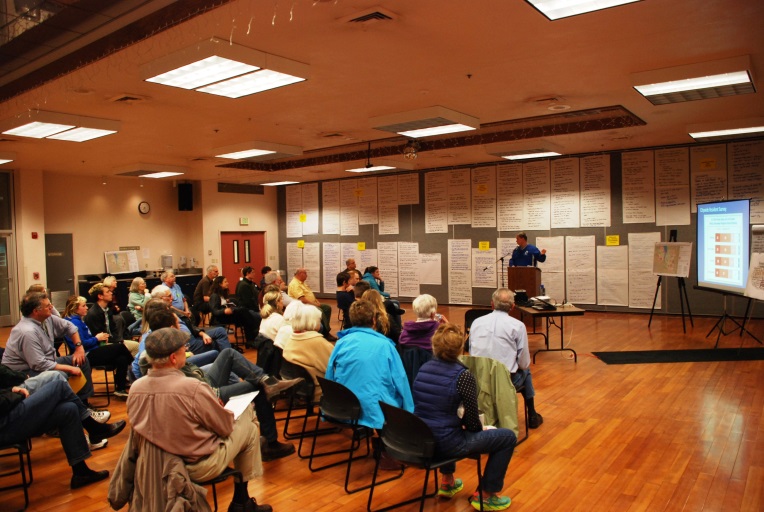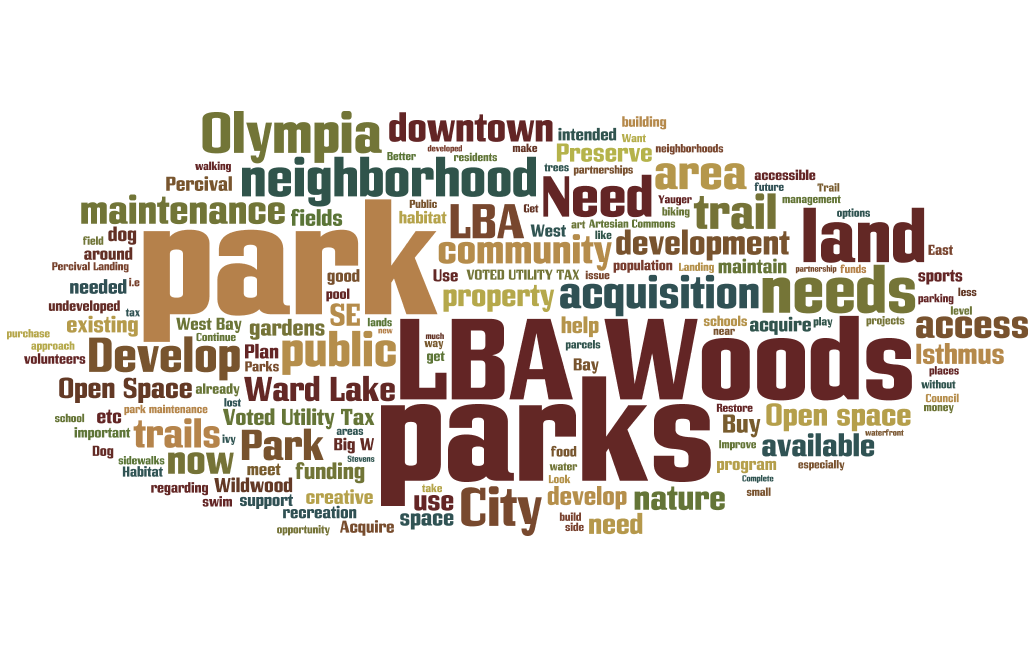Chapter 2 Public Involvement
One of the primary goals of the plan update was to reflect the needs of Olympia’s residents. Only through public involvement could we know how people perceive their needs. Throughout the planning process, the community was invited to help shape the future of their parks, arts, and recreation programs. This plan update has been based on community input that was gathered in the following ways:
• Meeting with Coalition of Neighborhood Associations to discuss outreach Strategy 10/13/14
• Series of eight neighborhood outreach meetings throughout Olympia 11/12/14 – 1/8/15
• Initial OlySpeaks on-line survey 12/4/14 – 1/9/15
• Community meeting 2/18/15
• Random sample survey of Olympia residents 3/20/15 – 4/5/15
• Public made aware of draft plan’s availability and public comment period via media releases, emails to all participants at initial public meetings, department newsletter, and posting on the City of Olympia’s homepage. 11/17/15
• Draft plan available on OPARD’s website 11/17/15
• A public comment period for the draft plan 11/17/15 – 12/11/15
• A public meeting on the draft plan [Scheduled for 12/2/15]
• Olympia Planning Commission review [Scheduled for 12/7/15]
• Olympia Arts Commission review [Scheduled for 12/10/25]
• Parks and Recreation Advisory Committee review [Scheduled for 12/17/15]
• Olympia City Council Public Hearing [Scheduled for 1/12/16]

Community meeting
Eight Neighborhood Outreach Meetings
From November 12, 2014 to January 8, 2015, OPARD staff hosted a series of eight neighborhood meetings. Each meeting was located in a different part of the City. There was strong participation at the meetings with 143 unique participants and 160 total participants (some people attended more than one meeting). At the meetings, participants were asked to identify what they felt was the greatest parks, arts or recreation need in their neighborhood and in the community as a whole. The following were the most dominant themes brought up at the meetings: (to see all comments, click here)

Dominant themes from neighborhood meetings
Most Dominant Themes (Topics mentioned 20 or more times)
• Buy the LBA Woods property
• Acquire land in general while it is available
• Buy open space/natural areas – provide nearby access to nature
Secondary Themes- (Topics mentioned 10-19 times)
• Provide more trails and trail/sidewalk connections to parks
• Utilize Voted Utility Tax as it was intended
• Construct an off-leash dog park
• Increase volunteerism/Park Stewardship Program
• Develop a park on the Isthmus
Other Common Themes (Topics mentioned 5-9 Times)
• Improve natural resource management/removal of invasive species
• Construct the “Big W” waterfront trail
• Provide swimming access/swimming pool
• Improve park safety/reduce park drug use
• Develop Ward Lake swim beach
• Develop West Bay Park/Trail
• Strengthen partnership with Olympia School District
• Develop more soccer fields
• Finish renovating Percival Landing
• Maintain existing parks
• Construct more community gardens
• Acquire heron rookery
• Foster partnerships
• Provide food forests in parks (fruit/nut trees, berry bushes)
OlySpeaks On-Line Survey
From December 4, 2014 through January 9, 2015 the City provided an on-line survey asking participants to identify what they felt were the greatest parks, arts or recreation needs in their neighborhood and in the community as a whole (the same questions as were asked at the neighborhood meetings.) This gave people who were unable to attend a meeting an opportunity to participate. Again there was strong participation with 119 comments submitted. Comments mentioned more than once are below (to see the comments in their entirety, click here)
|
Number of Similar Responses |
Input |
|---|---|
|
52 |
Purchase LBA Woods property |
|
9 |
Construct lit, synthetic turf soccer fields |
|
6 |
Construct West Bay Trail |
|
4 |
Construct a swimming pool |
|
4 |
Develop Log Cabin Road neighborhood park site |
|
3 |
Develop mountain bike trails |
|
2 |
Add amenities to West Bay Park |
|
2 |
Artesian Commons has drug problems, is not family-friendly |
|
2 |
Develop an off-leash dog park |
|
2 |
Foster stronger partnership with Olympia School District to provide shared fields/parks |
|
2 |
Fulfill promises made to the voters regarding the Voted Utility Tax |
|
2 |
Tear down Capitol Center Building and make Isthmus a mixed-use site |
Random Sample Survey of Olympia Citizens
From March 20 through April 5th, 4000 households selected at random were asked to participate in an on-line questionnaire. 759 people completed the questionnaire. This random sample survey was conducted by a well-respected professional survey consultant and conducted in a scientific manner. A summary of the results follow. (To see the complete survey report, click here)
95% of respondents report visiting a city park in the last year.
• 51% say they went to a city park 12+ times in the last year.
Nearly 1 in 5 (18%) had participated in a city recreation program.
City parks get an overall grade of "B-".
• Most respondents gave city parks an "A"(11%) or "B" (52%) grade
• The parks’ "grade point average" was 2.70 ("B-").
Park users are generally satisfied but not overly impressed by park maintenance.
• The overall grade for maintenance was is "C+" with each of 6 features getting a rating of "satisfactory" or better from a large majority of park users.
• Maintenance of playgrounds (GPA=2.62), trails (2.58), parking (2.51), sports fields (2.43), picnic facilities (2.42) and restrooms (2.14) were each rated "satisfactory" to "good" by a majority of park users.
Walking paths and restrooms were ranked as the "most important park features."
• Nearly 9 in 10 included walking paths (87%) and restrooms (86%) among their top five most important features.
• Majorities included picnic tables (67%), open grassy areas (57%) and playground equipment (50%) in their top five.
1 in 3 respondents said there are parks in Olympia in which they do not feel safe.
• A dozen specific parks were cited, headed by the Artesian Commons, named by 11% of respondents as a place where they do not feel safe.
About half of respondents (55%) had visited the Olympia Center in the past year.
• 15% had visited at least 5 times.
• 63% considered it to be a "safe facility"; 7% said unsafe; 31% had no opinion.
Respondents prefer a fairly balanced spending plan with a slight emphasis towards maintenance and improving existing parks but would allocate substantial funding towards land acquisition and development as well.
• Asked to distribute $100 across park priorities, on average:
$28.94 was distributed to maintenance and
$26.55 improving existing parks;
$25.02 to land acquisition;
$19.49 for develop new facilities on undeveloped sites.
Neighborhood parks were rated as the "most needed".
• Large natural areas ranked second with pocket parks ranked last
• Swimming facilities (outdoor and indoor) were the most frequently named item when respondents were asked if there were recreation facilities needed but not currently available in Olympia (18% named outdoor; 16% named indoor). In a separate question, however, swimming facilities ranked in the middle of the list of priority projects.
Respondents preferred more small open areas over one or two large open areas.
• By a 5:3 margin (58-35%) respondents chose several 1-10 acre parks over one or two 50+ acre parks "that would serve the entire city.”
Most people were at least "probably willing" to travel across town to large parks and open spaces. The smaller the park, the less willing people were to travel:
• 93% were willing to cross town to large open spaces like Priest Point or Watershed Parks (93% including 62% "definitely willing").
• 74% were willing for a community park such as Yauger or LBA parks (33% "definitely willing").
• 50% were willing to travel to a neighborhood park such as Lions or Decatur Woods (only 15% "very willing.").
Respondents rated several reasons as equally important for preserving open space.
• Water quality, wildlife habitat, public access and scenic value were each rated by more than 90% as important reasons to preserve open space.
Preservation of wetland habitat was ranked as the most important type of wildlife habitat to protect.
• Mature forest land, wildlife species and Budd Inlet shoreline were not far behind in the ranking.
Trails, natural open spaces and improved maintenance were ranked as the top priorities for the Department.
• These three items were ranked 1-2-3 from a list of 13 potential action items suggested by citizens at community forums.
• Improved safety, developing currently undeveloped neighborhood parks and removing invasive species made up the second tier of priorities.
No clear priority among six potential “megaprojects”.
• Asked to rank six potential projects, respondents scored the top four items in a tight cluster, headed by the Percival Landing project.
• Close behind were demolishing Capitol Center and completing the Olympia Woodland Trail.
• Acquisition of the LBA Woods ranked 4th, followed by developing the West Bay Park and Trail and Development of an Athletic Field Community Park.
Most respondents thought the city should sponsor and promote arts projects, including:
• Sponsoring large community events like Arts Walk (72%);
• Promoting arts activities happening in town (60%);
• Sponsoring small arts programs, such as neighborhood concerts (51%).
There was less support for arts capital projects, such as developing an Arts & Entertainment District, live/work housing, purchasing public art and monetary grants.
Sizeable majorities were at least "probably" willing to support a tax increase for both acquisition and development of recreational facilities and for maintenance.
• 71% said they would "definitely" (35%) or "probably" (36%) be inclined to support "an increase in taxes to pay for acquisition and development of parks trails and other recreational facilities."
• 75% said they would be "definitely" (28%) or "probably (47%) be inclined to support "an increase in taxes to pay for maintenance of parks, trails and other recreational facilities."
Most (58%) would trust the city to use the funds appropriately if funding measure were to pass.
• Only 10% would trust the city "completely"
• 48% would "mostly" trust the city.
• 28% would not trust that the funds would be used appropriately, including 8% who would trust the city "not at all."
Public Input Summary
Looking at the results of the various public input methods outlined above, one begins to see some common themes:
• Buy the LBA Woods property
• Acquire land in general while it is still available
• Buy open space/natural areas/trails to provide habitat value and access to nature
• Important to maintain what we already have
• Neighborhood parks very important


